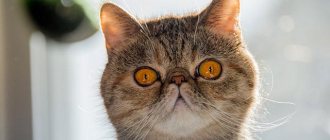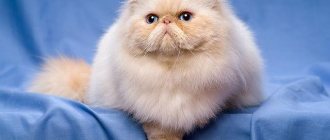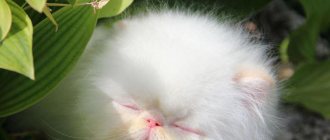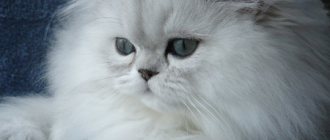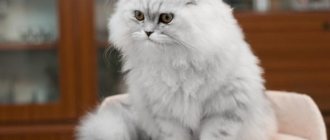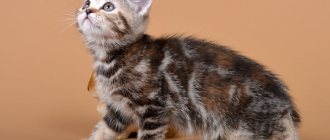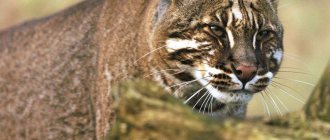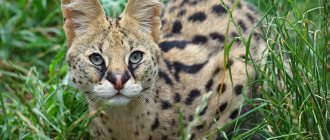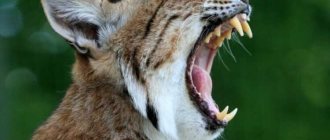Review author: “ZooVita”
Persians are incredibly beautiful creatures with rich fur and a cute flattened muzzle. They are loved by all cat lovers without exception. According to the description of the Persian cat, they are not just very cute animals, they have a wonderful character and are devoted to their owner.
The Persian always chooses one of the family members as his owner and, as a rule, does not change his affection. But there are also exceptions. We will talk about the characteristics of the Persian breed in this article.
Characteristics of the Persian cat - character and habits
The peculiarity of Persian cats is their phlegmatic temperament. These are extremely balanced and friendly pets, not at all adapted to life outside the home. They are among the breeds that are characterized by low activity. To people unfamiliar with the breed, this may be regarded as a physical ailment, which is not true.
Kittens and teenagers are more active and spend a lot of time playing. As pets get older, they prefer to spend most of the day sleeping and contemplating the world. At the same time, the Persian cat is quite capricious and does not tolerate when its freedom is limited.
Thanks to its calm character, the Persian cat easily gets along with everyone in the household: babies, elderly family members, and four-legged pets. Usually she does not show aggression and does not strive for dominance, but calmly accepts the dominance of others, remaining submissive.
Persians are known to be attentive parents. The mother cat takes diligent care of the kittens, teaching them the wisdom of life until they become fully independent.
Experts note the high intellectual abilities of Persian cats: you can and should work with them. The only condition: shouting and physical influence must be completely excluded. Classes should be conducted in conditions of goodwill and patience. Persians are touchy and vulnerable; rough treatment will cause stress.
The Persian breed is almost completely devoid of hunting instinct. The maximum that can be expected from it is hunting flies and butterflies that fly into the room.
Description of the breed
Today, the Persian cat is recognized by all felinological associations in the world. All existing breed standards have much in common. They describe the Persian as a medium-sized animal with a dense, square body. Wide bones, developed muscles, short and powerful neck, tightly built, stocky figure.
The judges evaluate correct proportions and harmonious build more strictly than compliance with the basic parameters. The body of the Persian cat seems much more massive due to the long, thick fur that hides the main outlines of the figure.
Appearance - what does a Persian cat look like?
- The Persian cat has a large head and a round, dome-shaped skull. The feeling of massiveness is complemented by pronounced cheekbones and chin, full cheeks. Persians are among the cats with pronounced brachycephaly: a breed feature - a short, upturned nose, a wide bridge of the nose, and a pronounced stop. An important proportion must be observed: the length of the bridge of the nose does not exceed the width. Another important detail: the chin is vertical with the nose or slightly protrudes beyond it. A correct bite is highly valued (a slight underbite is possible). Pronounced nasolacrimal lines diverge widely, ending at the corners of the mouth. Bite defects, long bridge of the nose, narrow muzzle are serious violations leading to fines and disqualification.
- Eyes are medium or large in size, round in shape. Direct delivery is required. The eyes must be set wide (the distance between the inner corners exceeds the size of the eye). The look is calm, as if a little surprised. An intense shade of the iris is welcome. Small eyes, oblong cut - a violation of the standard.
- The ears are small, straight set, with wide bases and rounded tips, devoid of tassels. The outside of the auricle is densely pubescent, and the inside is covered with long protective hair. Close set of ears is a violation of the standard.
- The body is quite large and massive. This impression is strengthened by a wide back, well-developed chest, round belly, and large bones. The width of the shoulder girdle corresponds to the width of the croup.
- The legs are proportional to the body and correspond to its format. They are short, strong, with developed muscles and strong bones. The paws are round and medium in size.
- The tail is straight, short, very richly furred. The pet holds it down towards the hocks. Tail defects (kinks, hooks) are a serious violation of the standard.
Today there are several subtypes bred at different times: classic, modern and extreme. Types of Persian cats differ in the structure of the head, the location of the nose relative to the line of the eyelids, and some skeletal features.
Classic type
The classic or obsolete type has the length of the bridge of the nose of the usual (classical) type. The nose is located significantly below eye level (6-10 mm). Due to the normal structure of the nasolacrimal ducts, the classic Persian does not experience any breathing problems.
These animals have a natural, natural exterior, due to which they are distinguished by good health and produce numerous offspring. In previous years, the classical type was considered the main one. Today, its popularity has fallen sharply, which has led to a decrease in the population.
European type
Cats of the modern short-nosed (or European) type have a nose raised to the level of the lower eyelid and eyes wide open. The nasolacrimal ducts of cats are deformed to a lesser extent than those of extreme sports, without causing major problems with breathing and eyes.
Today, the modern type is the most popular, since its representatives do not suffer from severe health problems.
Extreme type (American)
An extreme cat has an even more upturned nose (towards the inner corners of the eyes). The stop in such cats is maximally expressed and is located at the level of the upper eyelid. With this location of the nose, the nasolacrimal ducts are significantly shortened and deformed, which can create breathing problems.
Extreme sportsmen suffer from increased tearfulness. In this regard, the corners of the eyes and nasolacrimal grooves require daily care. Other features of the breed include a steep forehead line and low-set ears, which gives the pet a characteristic “frowning” facial expression.
This type of Persian cat was bred by American breeders, and therefore received the name “American”.
Size and weight
The Persian cat is of medium weight and size. The body weight of an adult pet varies from 3.5 to 7 kg (with height at the withers from 25 to 30 cm). The breed is characterized by sexual dimorphism: cats are much lighter (their weight does not exceed 3.5-4.5 kg), while the weight of a Persian cat reaches 7 kg (a classic Persian can weigh more).
Kittens are born very small: their weight does not exceed 90-100 g. Every month, they rapidly gain weight and by two years reach the weight of adult animals.
Table of weight of Persian cats by month:
| Age | Cat | Cat |
| newborn | 90-130 gr | 100-150 gr |
| 1 month | 390-460 gr | 410-530 gr |
| 2 months | 560-920 gr | 700-1100 gr |
| 3 months | 1-1.5 kg | 1.2-2 kg |
| 4 months | 1.4-2.3 kg | 1.7-3 kg |
| 5 months | 2-2.6 kg | 2.1-3.6 kg |
| 6 months | 2.2-3.4 kg | 2.6-4.4 kg |
| 8 months | 2.7-4.2 kg | 3.6-5 kg |
| 10 months | 3-4.5 kg | 4-5.9 kg |
| 1 year | 3.5-5 kg | 4.6-6.6 kg |
| 2 years | 3.8-5 kg | 5.2-7 kg |
Wool
The main pride of the Persian cat is its luxurious coat. Double-layer, thick wool not only provides reliable protection from winter cold, but also requires careful care. Thin, guard hair of a soft, silky texture can reach from 10 to 20 cm in length. The longest decorative hair forms elegant fringes on the chest, belly, hips, and tail.
Healthy fur is very beautiful, brightly colored, elastic and lively. Dull, faded, electrified cover indicates health problems or insufficient care. Due to the presence of a thick downy undercoat, the top coat does not adhere to the body, which makes the pet look even fluffier and larger.
Colors
The Persian cat is distinguished by an extraordinary richness of colors, and about a hundred of them are recognized as the standard.
The most popular type of color among Persians is solid (solid) . There are cats with uniformly colored coats (white, black, blue, red, lilac, cream). The combination of solid color with amber or dark orange eyes is very impressive. A white cat can traditionally have deep blue eyes or have heterochromia.
The tabbed color has three subtypes - striped, spotted and marbled. The standard allows any shades of tabby color.
Smoky is a rare type of color in which the coat is colored zonally (the base is lighter in combination with dark tips). Varieties include black, chocolate, lilac, gray, and blue smoke. The rarest type of tortoise smoke occurs in cats.
Bicolor is a popular type of color, representing a combination of colored and white shades (provided that the white zone occupies at least a third, but not more than half of the body surface). The tricolor cat of the Persian breed (calico color) combines three types of colors:
- white, black and red;
- white, blue and cream.
Color point is a very interesting type of color. Dark spots (brown, purple, black and blue are allowed in Persians) in the form of tan marks flaunt on the face, tail and paws. The body is always painted in a lighter tone. This variety was obtained by crossing the classic Persian with a Siamese cat and was called the Himalayan (some felinological associations distinguish color-point Persians as a separate breed).
Chinchilla is a unique type of color, the popularity of which is currently growing steadily. There are two subtypes: gold and silver. Thanks to zone-dyed hair, the impression of a beautiful, iridescent color is created. The undercoat and base of the guard hairs are light in color:
- silver chinchilla – white;
- golden chinchilla - apricot.
The very ends of the hair are black. A prerequisite: the nose, pads, lips and eyelids must be well pigmented.
tortoiseshell cat has a combination of several contrasting colors, which are located on the body in the form of the most bizarre spots and patterns.
Eyes
The eyes of the Persian cat are extraordinary. They are large, round in cut, straight set, wide open to the world. The color of the iris tends to match the shade of the coat:
- Most colors are characterized by amber and honey eye colors.
- The color of the chinchilla type corresponds to an emerald shade.
- All types of color-point colors have a rich blue iris.
- White color in combination with a light blue tint of the iris is highly valued among professionals
- There are white cats with heterochromic eyes.
All kittens are born with milky blue eyes due to insufficient amounts of melanin pigment. Kittens develop permanent eye color by about three weeks of age.
Appearance
Breeders today recognize only 3 breed subspecies:
Note!
Snowshu: description and characteristics of the cat, care and maintenance- Munchkin: description and characteristics, care and maintenance of a short-legged cat
Thai cat: description and characteristics, care and maintenance, choosing a kitten
Open it. Short-nosed Persian with an open look. Its main characteristic feature is the nose, with a slightly raised back, the tip of which is located at the same level as the movable fold of skin at the bottom of the sensory organ. Round eyes and no frown.
Extreme. The American type of Persian is distinguished by the fact that its nose and corners of the eyes, as well as the pits “deep into the nostrils” and the movable fold at the top of the eye are placed in one line.
Classical. In these cats, the nose can be positioned up/down, with the upper edge 0.5-0.6 cm below the lower skin fold. The obsolete type is not allowed for breeding, therefore it cannot compete with other intrabreed subspecies.
Life expectancy - how long do Persian cats live?
Persian cats with a good level of health live a fairly long cat life. The lower limit is approximately 15 years.
Sterilization before the onset of puberty, a sufficient level of physical activity, a well-designed diet, timely vaccination, and annual examinations by a veterinarian are measures that can extend your pet’s active years to 17-20 years.
It is of great importance which subtype the individual belongs to. Thus, Persian cats of the classic type can live up to 20 years or even more, while extreme cats rarely live up to 15 years.
Popular colors
Among all cat breeds, Persians occupy 1st place in the number of colors, or points (it is close to a hundred, and breeders continue to experiment with shades).
There are cats in white, cream, black, tortoiseshell, chocolate, red and blue. The body of some animals is covered with monochromatic (solid) wool, while the fur coat of others has several different shades (2-3). The color can be simple (the color of the coat matches the color of the undercoat) or complex (the fur hairs differ in color).
The following points are the most common:
- Classic or solid. This group includes tortoiseshell cats and individuals with uniform hair color. Tortoiseshell is a combination of red and black. Only females can have it. It has been established that animals with this coat color can rarely produce offspring, so their numbers are small.
- Silver or smoky. The base of the hair is light and the end is dark.
- Tabby. The animal's fur has alternating stripes, rings and marks, often red. Such animals have yellow, less often blue eyes.
- Agouti. Each hair is colored with alternating light and dark stripes.
- Chinchilla. 87.5% of the hair length is light in tone, the tip (12.5%) is dark. Cats with this color became common at the end of the 20th century.
- Two-color, or bicolor (have 2/3 white and 1/3 chocolate, lilac, black, blue, red or cream color).
- Calico. Tricolor animals, on the coat of which areas of white color alternate with cream and blue or red and black.
There is also a color point color. The cats' bodies are light, and their muzzle, tail and paws are dark. Some scientists call such Persians Himalayan and classify them as a separate breed.
Are Persian cats hypoallergenic or not? How often do they shed?
Persian cats are among the most allergenic breeds and are not recommended for keeping by people who have been diagnosed with an allergy to cat hair.
Skin particles, saliva, nasal and eye secretions of Persians contain a significant amount of the allergenic protein Fel d 1. By licking, they spread the allergen over the surface of the coat, from where it gets onto the hands and clothes of the owners.
The Persian breed is distinguished by particularly active shedding, which is often not seasonal, but permanent. Together with the fallen fur, the allergenic protein enters the air, and from there it goes straight into the respiratory tract of the owners. Frequently bathing your pet is the only measure that can help slightly reduce the amount of allergen in the apartment.
Genetics of color
The main tool for creating all shades of red is the orange gene (O). This is the only gene that is related to the sex of a cat.
A newborn Briton inherits from his parents a set of 38 chromosomes, 19 from each side. The genetic map of an animal includes all the characteristics (size, weight, height, coat length, color), as well as those that determine the sex of the baby. In cats, the combination of chromosomes looks like XX, in cats it looks like XY. The O gene attaches only to the X chromosome.
- In the dominant state, O forms a red color.
- In the recessive form, the coat tone is characterized as “not red” (in practice – black). But true charcoal color has its own B gene, which is not related to the gender of the kitten. Therefore, recessive orange was designated as “not red.” It is noteworthy that the dominant O suppresses the black color gene B. Even if one of the British parents has black hair and its trait is transferred to the baby’s genotype, the kitten will still receive a red color from the second parent.
- One X chromosome in British cats carries a single version (allele) of the O gene. In life, they can be either red (in the case of dominant O-) or not red (recessive o).
- Cats have two X chromosomes and three options for filling them: OO (red), OO (not red), OO (tortoiseshell, two-color red and black).
British boys always receive the color gene from their mother cat, regardless of paternal characteristics. That's why there are more of them. In the tortoiseshell combination of Oo alleles, sons are not born at all - the two necessary X chromosomes are missing. The only opportunity for British cats to become “turtles” is the XXY formula. But such animals always remain sterile, have no inheritance and cannot continue the color line.
The fashionable cream (peach) color is a variant of the red color. The D gene (lightener) comes into play. In the dominant form D- it leaves the coat color unchanged, and in the recessive allele dd it weakens the effect of the pheomelanin pigment. As in the main color, more peach cats are born than cats. Females are most often born not of one color, but of combined “turtles.”
Friendliness
Persian cats have a friendly, affectionate character. People call them cat intellectuals. Intrusiveness or persistence is not in their nature. A Persian cat will not meow loudly when begging for a treat. The pet will sit decorously next to you and wait for attention to be paid to it.
In any situation, the Persians will show peacefulness and try to avoid conflict. Aggressive attacks are very rare and are committed only in self-defense or in a state of severe fright. Its cause may be irritation or anger on the part of the owners, whom the pet trusts infinitely. A Persian cannot be picked up by the withers. His paws need constant support.
Persians and children
If there is a small child in the family, then you can safely get a Persian kitten: the kids will definitely make friends. But it will take a little preparation to prevent possible attempts at rough or cruel treatment of the animal in advance. The child should be explained that the kitten is not a soft toy. He also experiences pain, so you should handle him with care.
Older children can be charged with simple care of a pet, which will teach them responsibility. Grooming and feeding are serious procedures that require certain experience and knowledge. Only adult family members should do this.
Extreme character
Extreme cats are better adapted to life next to humans than other breeds. In the wild, in the wild, they quickly die. This is a sociable pet; it easily communicates even with capricious children and gloomy family members. The cat loves its owner all its life; from the first days of living in the house, it chooses a friend, protects him, heals him, and empathizes with his problems.
Persians are very sociable, they constantly require attention and love. If you move to a new place, you need to keep your pet near you. Otherwise, he will become sad and may get sick. The animal literally freezes without its owner. It refuses to eat and drink, and practically does not move alone. But with the arrival of a beloved family member, he comes to life and behaves very actively.
Extreme sports people show more concern for their offspring than representatives of other breeds. A cat during pregnancy and childbirth requires attention from the owner. She considers him a member of her family, so she often asks him to feed, scratch or pet him. She also expects him to actively participate in raising the cubs and feeding them.
But at the same time, the extreme female is torn between maternal feelings and responsibility to the owner. She strives to give as much care as possible to both humans and kittens. Therefore, a pregnant cat or one that has already given birth should be surrounded with affection, stroked and talked to more often.
Persians have different personalities, but they are never aggressive or angry. In childhood, cats are restless, active, and often keep their owner awake with their games. If you continue to maintain this state, then the adult extreme sportsman will also be active.
The breed is suitable for those who like to hug and touch cats; it calmly tolerates frequent touching and squeezing. Persians often lie on a sore spot, trying to take away the pain. Because of this, their immunity is weakened.
Attitude towards other animals
Being phlegmatic, the Persian cat gets along peacefully with other inhabitants of the apartment - a cat, a dog or even a parrot. The relationship between a Persian and a dog is often built on the basis of some kind of rivalry: the animals try to win the attention of the owner. An elderly dog may experience maternal feelings towards a kitten, caring for, protecting and tolerating the pranks of the little fidget.
Much of how the relationship between four-legged pets in a family will be built depends on the owner. He must make it clear that hostility between animals is unacceptable, giving each an equal amount of attention and care. If the wards do not show aggression towards each other, praise will be a good incentive for them.
Experts recommend keeping them at a distance for some time after animals appear in the house, allowing them to get used to it. Adaptation lasts about a week. If the animals ate from the same bowl for the first time or settled down to sleep on a common bedding, this indicates that the partnership is gradually improving.
When did the Persians appear?
It is believed that the Persian cat appeared about four hundred years ago. So, this incredibly beautiful animal literally amazed the Italian aristocrat. As a result of this, the Persian ended up in Italy.
A little later, a politician brought handsome men to France from Turkey. After some time, the red cardinal learned about the unprecedented beauty of the cat. It was he who became one of the very first who became seriously interested in the amazing breed and began to breed it. The Persians enjoyed wide attention at the French court.
Then they appeared in England. This was the beginning of the improvement of the breed. Now the appearance of these pets is known all over the world.
In Russia, these fluffy sissies appeared after the Cold War ended. In the eighties of the last century, diplomats brought them to the country.
How to cope with loneliness
Nature created cats with bright personalities. Despite the fact that they are attached to their owner and need to communicate with him, they remain self-sufficient. The Persian cat spends most of its time in a relaxed state, lounging on a soft sofa. Due to their phlegmatic disposition and inactivity, Persian cats are called interior cats.
Being alone for several hours will not be a serious stress for them. Having a sufficient amount of food in stock, the pet can easily wait for its beloved owner to get home from work. Upon returning, the owner must make amends: talk tenderly to the pet, accompanying the conversation with strokes.
If a longer absence from the owner is required, careful preparation is required. The animal should be safe and not feel abandoned and forgotten. The preparation points are:
- leave enough food and water;
- purchase an additional tray;
- close windows and vents, turn off taps and burners;
- instruct a friend or relative to come every day to feed, clean the tray and communicate with the pet.
Cream color genetics
The cream color in British Shorthair and Longhair cats is achieved by lightening the red, which is only possible when there is a lightening gene. A representative of the monochromatic group, today this color is rarely obtained by breeders. The right peach shade has a clean structure, rich shade in pastel colors. At the same time, the manifestation of a tabby pattern in the color of kittens, and residual tabby markings in adults, is not considered a defect.
If we delve deeper into genetics, the formation of cream color occurs as a result of the distribution of pheomelanin (yellow pigment granules) under the influence of the dilution gene (dd). Accordingly, the same rules apply for cream and red. British female kittens have the XX chromosome, boys - XY, these chromosomes are the determining factor for the formation of color.
In the genotype of cream females there are two genes for red color (O), localized on the X chromosome. Males have only one such gene. Each gene occupies a dominant (O) or recessive (o) position. Thus, female kittens with the combination “OO” will certainly be born red, with “oo” the offspring will not be red (black), and in the case of the “Oo” option, tortoiseshell-colored females will be born. Male kittens, due to the presence of only one X chromosome, can only be red and black. Male animals will inherit the color gene from their mother. So, if “OO”, then the cat will be red in color. With the second option “oo” the male kitten will be born black. And in the case of the third “Oo” scenario, the kitten will inherit the red color from its mother.
According to statistics, more males are born with cream color than females. When red, cream and all tortoiseshell variations of cats are crossed with animals of black and lightened variations, it is the cats that can be born cream. If you want to get cream kittens from your BRI e, then the partner must also be BRI e. However, in this situation, kittens may develop a pronounced pattern. If the male is red and heterozygous, in theory only half of the offspring will get cream, but in practice, any of the options can happen. It makes no sense to select partners of other colors, since BRI e female kittens will not be obtained. Only male kittens can be born with this noble shade.
In this rule, as in any other, an exception is possible, although it happens extremely rarely. For example, in a blue-cream cat, for some reason, the activity of all X chromosomes with the non-red gene (o) has been lost. Externally, the female will be cream-colored, and to check the genotype, you will need to resort to testing crossing.
Another gene is involved in the formation of color in kittens - the D gene (Dilutor, diluent). In the genotype - this gene affects lightening and can be either dominant D (no lightening) or recessive dd.
Breeders must take into account that the non-agouti (a) gene in red and cream cats does not affect the formation of the coat. Despite the fact that these colors are included in the category of “solid”, the color is unlikely to be perfectly uniform; rather, it will appear in spots, streaks and stripes. Meanwhile, it is possible to minimize the appearance of tabi patterns. Against a light background, areas of a different shade do not stand out as much as red ones. In addition, long hair can save breeders, thanks to which the pattern will be less concentrated. That is why long-haired light-colored Persian cats are the owners of an almost perfect cream shade. But it is almost impossible to remove the correct “cream” on cats with short hair. It is also necessary to take into account the fact that when replacing the undercoat with guard hair, the overall color may become darker. So breeders should not rejoice if the kitten is very light cream.
The offspring inherits color exclusively from the parents. Thus, a male and female BRI e can only produce cream kittens. And a pair of red (BRI d) kittens can be born cream only when both parents have the lightening gene (d).
It all starts at the embryonic stage of development. First, pigment cells appear, which are not yet able to produce color. They migrate to the hair follicles, take the form of an elongated capsule and are distributed along the length of the hair. The variety of colors in cats is the merit of only two melanins - red and black. British cats of peach (cream) color belong to the group of red cats, in which parents passed on the genetic pheomelanin inheritance to their offspring. Let's find out how the coat color of cats is formed and whether there are differences in the character of animals with peach color.
Cost of kittens
The cost of kittens depends on the assigned class, the presence of titles and awards from the parents, color, gender and age:
- The cost of a pet-class kitten is from 7 to 15 thousand rubles;
- The cost of a breed-class kitten is from 15 to 25 thousand rubles.
- The price of a show class kitten starts from 25-50 thousand rubles.
Having looked after the baby, they get to know his parents better and check the availability of a package of completed documents. The kitten is examined, paying attention to the condition of the skin, eyes, and ears. They check whether the baby is active, strives to communicate, and accepts the invitation to play. It is recommended to purchase breed and show class kittens not on your own, but with the help of a professional expert.
Two month old kittens are offered for sale. At this age, they acquire sufficient independence to leave their mother's nest. If a kitten is bought for exhibitions, then it is not recommended to take it from the nursery until it reaches the age of 4 months, when the breed characteristics are formed.
Care and maintenance
The Persian cat spends its entire life within four walls, and the owner must make sure that she feels cozy, comfortable and safe in the house. She needs to allocate a small, cozy place where she will rest and eat.
Pets tend to choose the most unusual places for themselves: it could be the drum of a washing machine, dryer or other mechanism. Therefore, before turning it on, you should always check to see if a furball has settled down to take a nap. Protective nets should be installed on the windows to prevent the cat from accidentally falling out.
The house must be protected from drafts so that a sharply slammed door does not injure the pet. All household chemicals and medications must be securely closed or put away in an inaccessible place.
What to feed
Persian cats are known gourmands; they are naturally prone to overeating and gaining excess weight. To prevent this, the diet must be carefully composed and the portion size controlled.
Experts recommend feeding peaches with high-quality industrial feed. The ingredients in them are correctly selected and balanced, and they also contain the necessary set of nutrients. The portion should be measured in accordance with the standards indicated on the packaging. Recommended brands of food include:
- Royal Canin Adult Persian;
- Pro Plan Optiderma Elegant;
- Grandorf Cat Indoor;
- Orijen Cat 6 Fresh Fish.
These are specialized foods designed for cats of long-haired breeds, including Persians.
Preparing natural diets for a Persian cat will require more time and effort. You will definitely need to add vitamin and mineral complexes to improve the condition of your skin and coat.
Choose lean meat in combination with vegetables (carrots, zucchini, pumpkin, cauliflower, broccoli). A useful addition is fermented milk products with a small percentage of fat content (cottage cheese, kefir, organic yogurt). The filling will be porridge with water (rice, oats, corn, buckwheat).
Occasionally, the pet is treated to a quail egg, a little sea fish, and unsalted cheese. It is recommended to include calcium and seaweed in vitamin and mineral supplements, which improve the brightness of color and elasticity of the coat (excluding cats with white hair).
For Persians, it is recommended to purchase wide and shallow bowls so that the fur is less dirty while eating.
Grooming
Due to the presence of a long and thick coat, the Persian cat is considered one of the most whimsical breeds. Its maintenance requires considerable time and material costs. To ensure that your pet has an attractive appearance, it is important to know how to care for its coat so that it always looks its best.
Persian wool has a very soft, pliable structure, which makes it prone to matting and matting. For care, purchase a special set of combs and combs with teeth of different sizes, a massage brush, a fuminator, and a slicker brush.
At first, breeders recommend brushing your pet several times a day, combining care with gentle words and stroking. This way, the pet will get used to it faster and will perceive the procedure more calmly. In the future, the Persian cat should be combed once a day, spending 15 to 20 minutes. Constantly removing dead hair will prevent tangling. Any tangles that appear must be immediately untangled or carefully cut out.
In the summer heat, some owners cut their pets' hair to save them from overheating. This procedure cannot be performed on cats attending exhibitions. After all, after a haircut, the wool changes its structure, and sometimes its shade.
Regular bathing (1-2 times a month) is good for the coat. Using moisturizing conditioners makes combing much easier. After the bath, the amount of Fel d 1 protein, a common cause of allergic reactions in sensitive people, is significantly reduced.
Special Needs
Due to the physiology of the Persian cat, its eyes and nasal passages require special care (especially important for extreme Persians). If the nasolacrimal ducts are deformed, then a characteristic feature of cats is respiratory distress and increased production of tear fluid.
To make nasal breathing easier for your pet, regular hygiene of the nasal passages is carried out, which allows you to increase the volume of air entering the lungs.
Dry eyes are carefully washed with warm boiled water or a special lotion, simultaneously removing traces of tear tracks. This must be done, since moisture tends to thin out the guard hair, leading to its loss.
The Persian's ears are cleaned as needed. The auricle is treated with a moistened swab. Removes traces of ear discharge without penetrating deep into the ear canal.
Potential Health Problems
Persian cats are prone to a number of hereditary pathologies. Some of them are related to physiological features. Most diseases can be asymptomatic for a long time, gradually turning into a more developed form. Only a specialist can diagnose them in a timely manner, so you should regularly visit the veterinarian’s office with your pet.
The main breed diseases of Persians are:
- Hypertrophic cardiomyopathy is a dangerous heart disease, the peculiarity of which is a long asymptomatic course. Treated through surgery. The percentage of occurrence in Persian cats is 6.5
- Polycystic kidney disease is a common hereditary pathology (up to 50% of pets suffer), a dangerous complication of which is kidney failure.
- Constantly dilated pupils in a pet often indicate a dangerous eye disease - retinal atrophy. The pathology leads to a gradual decrease in vision, up to complete blindness.
- Urolithiasis is a common disease in cats that lead a sedentary lifestyle. A good prevention of KSD is a properly formulated diet for the animal. The cat must drink enough liquid.
In more rare cases, Persians experience joint diseases, dermatitis, allergic reactions, and bite pathologies. An annual medical examination will help to avoid most diseases or diagnose them at an early stage.
What else does the breed manifest itself in?
In addition to the small, wide and perky upturned nose, another characteristic feature of the breed is its short and strong legs. So, in accordance with the standards established by the WCF and felinological organizations, the breed characteristics are determined:
- a small, undersized body with a wide chest and short legs;
- long, thick, soft hair often reaches 12 cm, the tip of the chic tail is rounded;
- round head with a convex frontal bone, plump cheeks;
- The low-set small ears are slightly rounded at the tips.
Wide-set, beautiful large eyes can be blue, light brown or various colors.
Note!
Bengal cat: description, characteristics and maintenance of an exotic breedNorwegian Forest Cat - description of the breed, character, habits and maintenance of the Norwegian (110 photos and videos)
- Cat litter - detailed review, prices, how to choose, where to buy
Pros and cons of the breed
Persian cats are valued for their friendly and easy-going nature. A phlegmatic temperament is regarded by many as an advantage, because thanks to their calm disposition, pets easily adapt to the proposed living conditions and get along with other four-legged inhabitants of the apartment. They do not strive for dominance, are not annoying, but happily accept affection. If the owners are busy, they calmly experience these moments.
The Persian cat is suitable for families with children: it is not aggressive, patient, and will not release its claws or bite when playing.
The undoubted advantage of the Persian is its attractive appearance, harmonious build, and extraordinary richness of colors.
Among the most significant disadvantages of the breed is a significant number of breed hereditary pathologies. The Persian cat is fastidious in its care. The owner will have to spend a certain amount of time every day tidying up the pet’s coat. The Persian is one of the most allergenic breeds, which must be taken into account by sensitive people.
History of the breed
The first Persian cats were brought to Europe by the Italian Pietro della Vale back in the 16th century. He received the animals as a gift while traveling in Iran (Khorasan). In appearance they were very different from modern cats from the east. In particular, they had a muzzle of normal length, and the shape of their eyes was slightly oblong. The Persian breed immediately gained recognition. Many rich people, following fashion, sought to have an oriental beauty.
Work to improve the qualities of the breed began only in the 19th century. At first, breeders paid attention to the properties of wool and improving body proportions. The British National Cat Club has identified two varieties of the Persian breed. The first type (fine bone, light coat, wedge-shaped head, pointed ears) was classified as the Turkish Angora. Another type (strongly built, round head, short legs) was registered as the Persian Longhair.
In the twentieth century, American breeders carried out work to change the exterior of the Persian cat. Paying tribute to fashion, breeders set out to develop a new type, called extreme. Its features: an extremely short muzzle with a shortened bridge of the nose, stops at the level of the upper eyelids, wide open eyes. By crossing a classic Persian and an American shorthair cat, the breeders got an exotic cat. Her short, seemingly trimmed coat was velvety to the touch and did not require such careful grooming.
Numerous breeding experiments were carried out with the aim of breeding cats with unusual appearance and exterior features. A side effect of these experiments was the production of animals with physical characteristics and a tendency to genetic pathologies. British felinologists preferred to stick to the classic type of the Persian breed.
History of the Persian cat with photos
Persians were brought to France in the 16th century from Persia, and later to Britain. Interest in furry pets dates back to the Victorian era. And already in the nineteenth century, a new standard was established for Persian cats, which today is the closest to modern Persians.
The fluffy breed sailed to Foggy Albion in the nineteenth century and immediately conquered the entire continent. Unlike English fans of this breed, Americans classify all the color colors of longhaired Persians as one type of Persian, without separating them.
Now the world knows more than 100 species of these long-haired cats, which, with the help of their owners, have become like a masterpiece of art.
Persian pets appeared in Russia only in the late 80s of the twentieth century. Having been brought by diplomats from developed European countries, they became something of a curiosity.
In the 90s, Persians were distributed throughout the country, but were quite an expensive purchase for a simple worker.
Interesting facts about Persian cats
- A representative of the Persian breed was included in the Guinness Book of Records for the longest fur. This is a cat named Colonel Meow. The length of the decorating hair was 22 cm. Unfortunately, the cat died in 2013.
- Animal rights activists call the Persian breed one of the most affected by experiments in breeding extreme forms. Some countries legislate a ban on breeding animals with characteristics that lead to serious hereditary pathologies.
- Crossing a long-haired Persian with a Siamese cat gave rise to the development of a very beautiful Himalayan breed. Some felinological associations consider it as an independent breed, others - as a variety of the Persian breed.
Health
Characteristic diseases
The health of Persian cats, like that of Neva masquerade cats , is average.
Unfortunately, they are characterized by hereditary diseases, since as a result of strict selection, along with positive qualities, negative qualities are acquired and, worst of all, sometimes negative ones are fixed.
Persian cats suffer from:
- cardiomyopathy, which can cause death even in a young cat;
- kidney disease, in some cases it comes to kidney failure;
- progressive retinal atrophy leading to blindness;
- increased lacrimation;
- difficulty breathing due to a small flat nose;
- dental diseases - gingivitis, periodontitis, formation of tartar and plaque.
Due to the long hair that cats constantly lick, lumps form in their stomachs. To remove them, special pastes and tablets are required.
Vaccinations
Annual quadruple vaccination if the cat is not exported abroad, and if necessary, vaccination against lichen.
Before vaccination, the cat should be given an anthelmintic. Kittens aged 4 to 9 months are not vaccinated because they are changing teeth.
Photo
Owner reviews
- Svetlana. I have extreme-type Persians Timofey and Benjamin, who are completely different in character. If Tim is independent and does not need company at all, then Venya can be freely picked up and squeezed, he really likes it. Venya always needs communication. When Tim refuses to play with him, then I have to do it. Venya’s favorite toy is a ball of paper that you throw, and he will bring it back in his teeth. And Tima loves to tear up wallpaper, despite the fact that the house is full of scratching posts. Tim has been accustomed to dry food since childhood and does not recognize other food. And Venya loves yogurt, eats it with pleasure and slurps loudly with pleasure.
- Sergey. We have a cat of the Persian breed with beautiful, moderately thick hair of a smoky color. I never tire of admiring her: Marcy radiates calmness and friendliness with her entire appearance, which can be envied. She sleeps or walks around the house all day, watching what is happening. She has never scratched or bit anyone yet. In general, a real keeper of the house.
- Irina. We have a kitten, very fluffy and soft, but, oddly enough, he did not shed much either in summer or autumn. My special shampoo for kittens with long hair – Marsik likes it. As befits kittens, he is very active, playful and, which is not typical for Persians, loves to meow loudly. He often sleeps in a box so that no one can find him. Sometimes punctures happen: he walks past the tray. We are fighting this habit, but so far without success. We forgive him everything and love him more than anyone in the world!
Animal care
Extreme people are quite curious and naive, they taste all small objects, climb into closets and laundry baskets. Suitable living conditions must be created for them. All medicines and medications are placed in closed places, and in the kitchen the pet is protected from hot surfaces and sharp instruments. It’s also better not to leave dirty dishes in sight; the kitten will definitely try to lick them.
Before turning on, check household appliances. A small animal can simply fall asleep in a washing machine, open multi-cooker or oven. It is recommended to put strong nets on the windows; balconies should be closed. Extreme sports enthusiasts love to sit on the windowsill and watch the movements on the street.
It is imperative to take care of the long hair of Persians. This is an entire art that requires the use of special means and tools. The cat is brushed several times a day. First, they go over the hairs with a brush with sparse teeth, then carefully comb the thicker ones, and at the last stage use a fine comb. After this, spray the fur coat with conditioner or strengthening spray. It is recommended to use antistatic agents.
The extreme sports enthusiast is bathed several times a week with a special shampoo. Kittens are afraid of water at first, but gradually get used to it. After the bath, blot the coat with a large terry towel and comb until completely dry. Periodically, you need to cut your cat's hair without touching its tail. But scissors should not touch a color-point pet, otherwise its pigmentation will be disrupted.
It is important to choose the right diet for extreme sports enthusiasts. Natural feeds are mixed with industrial ones; almost half of the daily intake should be proteins. Persians happily eat lean veal and pork, chicken and turkey, dairy products and legumes. The source of carbohydrates will be wheat and rye bread, cereals and porridges, oatmeal and root vegetables.
Many vitamins and minerals are found in raw and boiled vegetables, asparagus, herbs, olives, and fruits. You should not include flour sweets, spices and seasonings in your diet. If you teach a kitten to catch mice from the age of three months, he will grow up to be a good hunter.
Similar breeds
The British Longhair cat is the closest relative of the classic British Shorthair. Has a lot in common with the Persian cat. Common features include a calm, phlegmatic character. The cat is friendly and affectionate, but periodic solitude is necessary for her, so the owners can easily go away on business and to work. The pet shows a desire for independence and does not accept frequent hugs and cuddles. The structure of the coat resembles that of a Persian cat. The difference is that it is not prone to matting, so you can care for it a little less often than Persian fur. Cats are prone to overeating; the composition of the diet and portion size must be carefully verified. They may have character difficulties, be somewhat capricious and uncontrollable.
Exot is a half-Persian cat (Persian and American Shorthair participated in the breeding). The pets have retained the characteristic appearance of a Persian cat with an upturned nose and large round eyes. The characters of the Persian and the Exotic have a lot in common - they are affectionate, affectionate, friendly and love children. The intelligence of the short-haired beauty is also at its best. Thanks to his good memory and flexible nature, he is willing to learn and is able to learn several simple commands. The exotic has short, thick fur, the structure of which resembles soft plush. Since the exotic coat is easy to care for, its maintenance is less troublesome. In addition to the American Shorthair, Burmese cats and representatives of the Russian Blue breed participated in the development of the exotic breed.
Cream color standard
Breeders invested a lot of time and effort into creating the ideal cream color in British cats during their breeding process. As a result, we managed to get a cold and very rich shade. Britons of this color are able to restore the energy balance of their owner. The wool of “kremacs” is no worse than that of blue and lilac colors - thick, smooth and soft to the touch. Simply petting your “teddy” friend is enough to get rid of tension and fatigue.
The cream color in British cats is coded “Cream BRI e” and is one of the solid colors.
The cream color of representatives of this breed is often called “peach.” The coat is colored a light cream shade evenly from root to tip throughout the cat's body. If there are undyed white hairs in the color, the pet is rejected from breeding. The presence of tabby markings (spots, stripes, tail rings, specks, etc.) on individuals of this color is also not welcome.
Cream Britons are characterized by pink, unpigmented noses and paw pads. The eyes can be copper, dark golden, orange, and are very harmonious with the color of the coat.
The peachy Briton is incredibly handsome. However, it is very difficult to breed a pet with the ideal color, which is why such cats are extremely rare.
The cream cat is a genetic modification of the red cat. In the latter, the shade directly depends on the sex of the animal - males are born more often than females. Purebred cream British are also rare because in the early days of their breeding, breeders did not have an exact recipe for obtaining such a refined shade.

